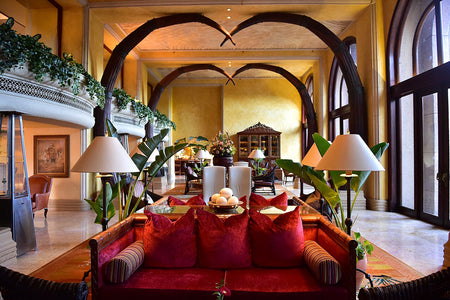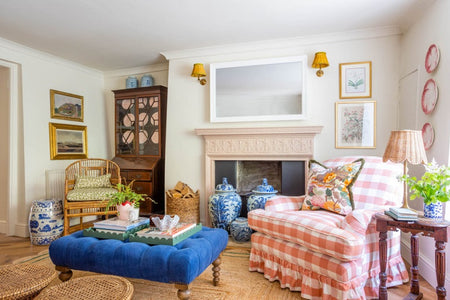
Calm, order and a simple, timeless beauty… If you want a little Shaker style in your life, here’s a Pooky guide. And, naturally, we’ll give you some ideas on how best to light a Shaker-influenced home....
Inspiration for interior design styles springs from all kinds of sources. Art and architectural movements, from Rococo to Bauhaus, have always been a big influence. There is the impact of economic and social change: utility furniture was a response to the wartime shortages, and then the changing patterns of women’s lives demanded homes that were easy to maintain. In the 21st century, sustainability and environmental concerns have become increasingly significant. But, as we saw with Zen interior design, spiritual practices and belief systems have also made their mark – and that is the case with Shaker style.
Above and top - Shaker stone house restoration, Pennsylvania. Image credit.
The origins of Shaker style
The history of the Shakers, or to give them their full name, the United Society of Believers in the First and Second Appearance of Christ, began in the late 1700s in the Manchester slums. A group of Anglican dissidents, led by Ann Lee, who was poor and uneducated but distinctly charismatic, broke away from the established church and became known as the Shaking Quakers (so-called because a ‘shaking’ dance worship formed part of their spiritual practice). Like other non-Conformist groups before them, they hoped that the new world of America could offer them the religious freedom they sought and, in 1774, Ann, together with eight followers, arrived in New York. The Shakers went on to become ‘America’s largest and best-known communal utopian society,’ (Shaker Life, Work and Art, June Sprigg and David Larkin). Shaker life was based on equality, communalism, cleanliness and celibacy and, by 1840, the original nine had become 6,000. Adults who joined the Shaker movement brought skills such as carpentry, metalworking, farming, weaving and dressmaking, with them and Shaker communities, in states like New Hampshire and Maine, became renowned for the quality and simplicity of their work.
Shaker houses, Canterbury, New Hampshire
Numbers dwindled (perhaps not entirely unrelated to the emphasis on celibacy) and by 2017 there were reported to be just two surviving Shakers, then aged 62 and 80. But the legacy of their fine craftsmanship lives on. The latter half of the 20th century saw a surge in the popularity of Shaker design beyond the USA. Marylebone, London had its own (now much missed) Shaker shop and at least one UK company still makes Shaker-influenced furniture and accessories. A comeback is surely due soon!What is Shaker style?
Underpinning all Shaker style, from the interiors and exteriors of houses to furniture, accessories and clothing, was a commitment not only to functionality, neatness and extreme simplicity but also to finished work of the highest quality – perfection equalled godliness. Rooms were sparsely furnished only with essential items – whether large spaces for communal use such as kitchens, or small private areas like bedrooms.

Shaker kitchen in Pleasant Hill, Kentucky (Image credit); Shaker bedroom (Wiki commons)
No embellishment, nothing fancy, no beadings, mouldings or motifs. It makes the Shaker style timeless - and if you have a penchant for minimalism, you may find that Shaker style could suit you very well.
The Shaker colour palette

Shaker hall in Pleasant Hill, Kentucky (Image credit)
Shaker interiors emphasised light and lightness and the traditional Shaker colour palette reflects this, with walls and ceilings of soft white or cream. Contemporary interpretations of Shaker style often make use of darker colours, such as deep grey, especially in kitchens. If you like this approach, balance dark features with light and make the most of natural light.
Shaker style painted panelling in a modern kitchen by Tom Howley. Image credit
The importance of natural wood
While household joinery such as skirting boards or window frames could be painted in light colours, it was frequently left in its natural state, displaying the original grain and, over time, the patina. Shaker joinery skills were put to particularly good use in crafting plain but innovative storage systems and cupboards, such as these amazing built-in cabinets at Hancock Shaker Village:
Image: Hancock Shaker Village
If you want to introduce just a touch of Shaker style wooden storage systems, sliding doors such as these, are unobtrusive and space efficient. But no items of Shaker joinery are more instantly recognisable than the bentwood boxes, carriers and trays, with their repeating pattern of fingers, known as ‘swallowtails’. Baskets of all sizes were also used for portable storage; these traditional Shaker items are just as practical as they are stylish for the modern home.
Lighting your Shaker style home
It’s sometimes assumed that, as with the Amish, Shakers eschewed modern inventions like electric lighting. But in fact Shaker communities were among the earliest adopters of innovative items like electrical appliances and telephones, although candles were also widely used, often fitted into wall sconces. To stay true to Shaker style principles, we recommend keeping things as plain and natural as possible, whether you’re choosing fixed overhead or portable lighting. Look for shades and fittings made of glass, metal or wood and plain rather than patterned lampshades and fittings.Pendant lights
Pendant lights are a smart but practical option in kitchens, dining areas and entrance halls. How about the simply stylish black exterior and white interior metal Dexter in your kitchen? For an eye-catching but understated pendant light in a dining area, Pooky’s Qilin is a great choice – a classic curved cone shape, made of molten glass, gently fluted. If you prefer an opaline glass, take a look at our pleasingly plain, round Espere.
An entrance hall needs to be well lit and we think the clean lines of our Carrington lantern, which features clear glass set in an antiqued brass frame, would be ideal.
Table lamps
Choosing a table lamp made of simple turned wood will keep you on the right Shaker style track. Pooky has a range of wooden lamps that fit the bill, like Daisy, made of whitewashed wood. Try it paired with a plain Empire lampshade made of cream card. If you want a table lamp made of a darker wood, Pooky’s Lillee is available in an ebony finish; an Empire shade in natural vellum tops it off handsomely – and simply!
Floor lamps
We’re keeping it simple with suitably Shaker floor lamps too, and they don’t come more streamlined that our antiqued brass, Trafalgar. We’ve put it together with another plain Empire shade but this time, in taupe dupion silk. Nicely neutral but with an undoubted touch of natural luxury – all boxes ticked!
More in our series 'Classic interior design styles and how to light them': 1. Mid-Century Modern 2. English Country House style 3. Industrial style 4. Eclectic style 5. Coastal style 6. Scandinavian style 7. Art Deco 8. French chic 9. Shabby chic 10. Zen 11. Modern Rustic 12. Bohemian















